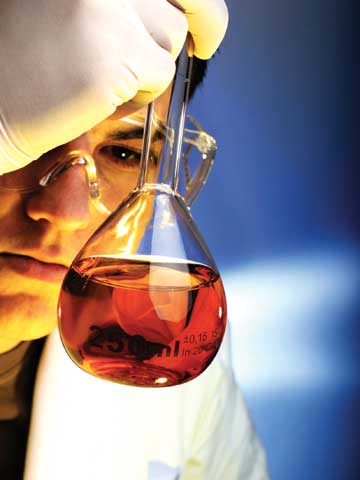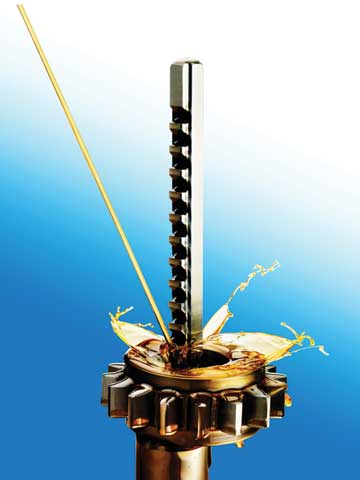How Healthy is Your Equipment?
Check the Lubricants with an Oil Analysis Program
Lubricants are the lifeblood of industrial machinery. They protect critical components and help promote enhanced operation, just as blood supports health in the human body. And, while a doctor learns valuable information about a patient's health through a blood test, you can discover valuable insights about your equipment using routine oil analyses.
Oil Analysis & its Benefits
 Oil analysis is based on a slate of tests designed to help evaluate the condition of internal hardware as well as the inservice lubricant. It is a quick and non-invasive way to gauge the health of a machine by looking at what's in the oil. Factors such as a lubricant's properties, suspended contaminants, and wear debris are analyzed by specialists in a laboratory. Regular testing allows personnel to monitor contamination levels and guarantee the optimum lifespan of machines and other critical plant equipment.
Oil analysis is based on a slate of tests designed to help evaluate the condition of internal hardware as well as the inservice lubricant. It is a quick and non-invasive way to gauge the health of a machine by looking at what's in the oil. Factors such as a lubricant's properties, suspended contaminants, and wear debris are analyzed by specialists in a laboratory. Regular testing allows personnel to monitor contamination levels and guarantee the optimum lifespan of machines and other critical plant equipment.
When oil analysis sample results are tracked over a period of time, maintenance trends can be identified, helping machine owners avoid costly repairs and sudden breakdowns. Today, oil analysis is performed in line with routine maintenance programs to provide precise, significant data on lubricant and machine condition. With regular oil analysis and a good maintenance program, machine downtime can be reduced significantly, hence reducing the potential dangers of a repair process and allowing workers to function with improved safety. In addition, oil analysis can also extend oil life especially when used effectively in pinpointing the proper oil drain and filter change intervals of different lubrication systems, thereby reducing waste and supporting environmental awareness. Oil analysis also supports environmental awareness, as it maintains the cleanliness and efficiency of hydraulic oil systems, combustion engines, and other industrial machinery.
 Assimilating the Oil Analysis Program into Maintenance Regimes
Assimilating the Oil Analysis Program into Maintenance Regimes
The importance of a routine oil analysis program is clear, but knowing where to start requires some guidance. Here is a simple seven-step process to get an oil analysis routine started:
-
Step 1: Identify "Mission Critical" Equipment It is not necessary to perform oil analysis on every single lubricated system in a plant. Identify critical applications that would seriously jeopardize production if they were to shut down unexpectedly.
-
Step 2: Register Your Equipment It is important to have equipment properly registered with the laboratory. This supports routine trending and plays a key role in early detection of lubricant or equipment problems. There's no need to decide which tests are appropriate for a particular application because the laboratory has already established test slates for specific applications.
-
Step 3: Establish Best Practices Establish a consistent "how-to" practice for taking oil samples and train maintenance personnel to use this practice. Correct sampling practices are critical to the value received from the analysis data. This extremely important step rarely gets the attention it needs.
-
 Step 4: Retrieve Samples Retrieve samples in accordance with best practices and send to the lab as soon as possible. Samples that are set aside may deteriorate and give non-representative results.
Step 4: Retrieve Samples Retrieve samples in accordance with best practices and send to the lab as soon as possible. Samples that are set aside may deteriorate and give non-representative results. -
Step 5: Analyze A thorough analysis, keyed on trends, helps determine the systems' conditions. General laboratories may have a pretty good idea of what is being measured, but often know little about specific formulations and don't always understand whether or not differences are significant.
-
Step 6: Interpret Reviewing the results and determining what, if any, action is required can make or break a successful program. It is important to remember that a sample alert does not necessarily mean imminent failure. Seek consultation on alert samples and re-sample to confirm present data before taking massive corrective action.
-
Step 7: Take Corrective Action and Document, Document, Document!!! As always, documentation is the key to knowing what has been done and what will be or needs to be done. Historical oil analysis and corrective action documentation will ensure that safety, environmental care and productivity are maximized.
